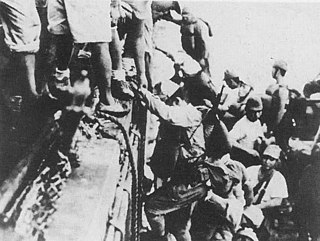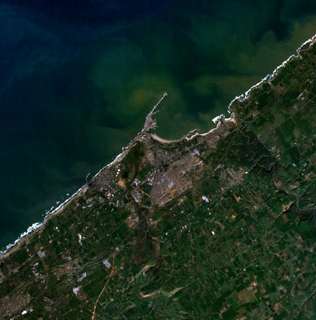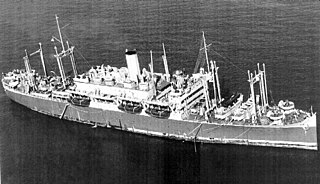Related Research Articles

The Kriegsmarine was the navy of Nazi Germany from 1935 to 1945. It superseded the Imperial German Navy of the German Empire (1871–1918) and the inter-war Reichsmarine (1919–1935) of the Weimar Republic. The Kriegsmarine was one of three official branches, along with the Heer and the Luftwaffe of the Wehrmacht, the German armed forces from 1933 to 1945.

Operation Torch was an Allied invasion of French North Africa during the Second World War. The French possessions in the area were ruled by the Vichy French, formally aligned with Germany but of mixed loyalties. Reports indicated that they might support the Allies. American General Dwight D. Eisenhower, supreme commander of the Allied forces in the European Theater, who wrote about Operation Torch in his memoir, Crusade in Europe, directed the operation, and planned a three-pronged attack on Casablanca (Western), Oran (Center) and Algiers (Eastern), then a rapid move on Tunis. The goal of Operation Torch was to open a second front in Europe, as per request of Joseph Stalin, the leader of the Soviet union.

USS Brooklyn (CL-40) was a light cruiser, the lead ship of her class of seven, and the third United States Navy ship to bear its name. Commissioned in 1937, she served in the Atlantic during World War II, as a convoy escort and as fire support for amphibious landings.

USS Ellyson (DD-454/DMS-19), a Gleaves-class destroyer, is the only ship of the United States Navy to be named for Theodore Gordon Ellyson, a submariner who became the first officer of the U.S. Navy to be designated a naval aviator.

The Tokyo Express was the name given by Allied forces to the use of Imperial Japanese Navy ships at night to deliver personnel, supplies, and equipment to Japanese forces operating in and around New Guinea and the Solomon Islands during the Pacific campaign of World War II. The operation involved loading personnel or supplies aboard fast warships, later submarines, and using the warships' speed to deliver the personnel or supplies to the desired location and return to the originating base all within one night so Allied aircraft could not intercept them by day.

USS Cleveland (CL-55) was the lead ship and one of the 27 United States Navy Cleveland-class light cruisers completed during or shortly after World War II. She was the second ship to be named for the city of Cleveland, Ohio.

USS Lyon (AP-71) was a type C3 ship of the United States Navy which played an extensive role in naval transportation during World War II. The Lyon was built as Mormactide under a Maritime Commission (MC) contract by the Ingalls Shipbuilding Company of Pascagoula, Mississippi. She was laid down 21 August 1939, and was launched on 12 October 1940; sponsored by Gloria McGehee.

USS Gunnel (SS-253), a Gato-class submarine, was the only ship of the United States Navy to be named for the gunnel.

USS Hogan (DD-178/DMS-6) was a Wickes-class destroyer in the United States Navy during World War II. She was the first ship named for Seaman Daniel Hogan.

The Battle of the Mediterranean was the name given to the naval campaign fought in the Mediterranean Sea during World War II, from 10 June 1940 to 2 May 1945.

Operation Brushwood was a part of Operation Torch, Allied landings in Africa during World War II.

USS Ancon (AGC-4) was one of three identical ships built for the Panama Railroad Company put into operation in 1938. The ship was converted to a troop ship by the Army in January 1942, making several voyages to Australia with troops as an Army Transport. In August 1942 the ship's operation was transferred the United States Navy for the duration of World War II and converted to a combined headquarters and communications command ship.

USS Murphy (DD-603) was a Benson-class destroyer in the United States Navy during World War II. She was named for Lieutenant John McLeod Murphy.

USS Joseph Hewes (AP-50/APA-22), formerly SS Excalibur, was a troop transport for the United States Navy during World War II commanded by Captain Robert McLanhan Smith Jr. A part of the Center Attack Group of Admiral Hewitt's Western Naval Task Force, Operation Torch, Joseph Hewes was sunk on November 11, 1942 by the German submarine U-173 in Fedala Roads off French Morocco coast during the Naval Battle of Casablanca.

USS Hugh L. Scott (AP-43) was a Hugh L. Scott-class transport ship. She was built in 1921 and spent 20 years in merchant service as a passenger and cargo liner. She was acquired for the United States Navy shortly before the USA entered the Second World War, served as a troopship in Operation Torch in November 1942, and was sunk by a U-boat four days later. 59 crewmen and soldiers died during the sinking.

SS President Cleveland was originally built as Golden State for the United States Shipping Board (USSB), one of the planned World War I troop transports converted before construction into passenger and cargo vessels launched as Emergency Fleet Corporation Design 1029 ships first known, along with the smaller Design 1095 versions, in the trade as "State" ships due to names assigned for the nicknames of states and later as "535s" for their length overall. Almost all ships of both designs were renamed for United States presidents by May 1921, with Golden State being renamed President Cleveland. As one of the USSB-owned ships operated by agents of the board, President Cleveland was allocated to and operated by the Pacific Mail Steamship Company until sold by the USSB to the Dollar Steamship Line in 1925. After the demise of that line and creation of a new, replacement line, American President Lines, the ship remained with that line until government acquisition for the Second World War.
USS Edward Rutledge (AP-52/APA-24) was an Edward Rutledge-class troop transport (AP), later re-designated as an attack transport (APA). She was acquired by the U.S. Navy for use in World War II, and was assigned the task of transporting troops to and from battle areas. Operating in dangerous Mediterranean waters on 12 November 1942, she was sunk after being struck by a German submarine’s torpedo at Fedala Bay, Morocco.

USS LST-348 was a United States Navy LST-1-class tank landing ship that was built and deployed during World War II. The ship was constructed throughout late 1942 and early 1943 before being deployed to the European theater, where it undertook supply operations in support of Allied troops in North Africa and Italy. It was sunk by a German U-boat in February 1944.
References
- ↑ Morison, Samuel Eliot. History of United States Naval Operations in World War II: Operations in North African Waters, October 1942-June 1943, Volume 2. Naval Institute Press. p. 168.
| This Morocco location article is a stub. You can help Wikipedia by expanding it. |
| This article about a specific oceanic location or ocean current is a stub. You can help Wikipedia by expanding it. |